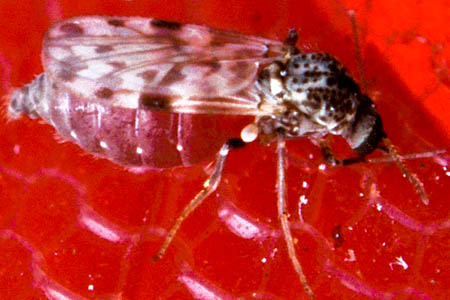
Culicoides sonorensis, a cousin of the meanbh-chuileag which causes misery to many hillwalkers
They can turn a pleasant walk into a nightmare; they hunt by sense of smell and bring misery to many visitors to the Highlands and other areas of the great outdoors.
The humble midge may have a wingspan of only 2mm, but its diminutive size is out of proportion with the problems it brings as swarms of thousands of the bloodsucking beasties seemingly take over large areas of the outdoors. Peak nuisance season for the Highlands is from now until September, and today sees the 2009 launch of the Scottish Midge Forecast website.
The site lies dormant in the winter months, but comes alive as the eggs of Culicoides impunctatus hatch and the meanbh-chuileag – its Gaelic name – prepares to wreak its misery upon unsuspecting walkers and climbers.
The midge forecast site is the brainchild of Edinburgh University’s Dr Alison Blackwell, who formed Advanced Pest Solutions in 2004 to forecast and mitigate midge activity.
Forecasts are based on information about midges caught and weather data. Areas of Scotland are rated on a map, from level one – negligible – to level five – nuisance. On the forecasts site’s first day, the whole of the country has a level one risk apart from Glencoe, which is at level two, still classed as low-level.
Scotland has about 40 species of midge, but worldwide there are more than a thousand. Whereas the male of the species is vegetarian, feeding mainly on plant sugars, the female is the villain of the story, as she needs blood to mature her eggs.
She has 500 different sensory hairs on her antennae to tune into the scent of humans and other potential victims. Carbon dioxide, exhaled in large quantities by hillwalkers and climbers huffing and puffing up the munros and other mountains of the country, is also sensed by the midge.
Peat bogs are a favoured breeding ground for the insect in this country, and a single female can lay more than 200 eggs in her lifetime.
Various preventative measures can be taken, from midge hoods and nets to insect repellent. Indeed the Scottish Midge Forecast site is sponsored by one. Many squaddies, including the Royal Marine Commandos, swear by a product produced by a major cosmetics company and marketed originally as a bath-oil.
Bats and some birds feed on midges. Midge bites are also thought to be the transmission mode of blue-tongue virus in farm animals.
The forecasts can be seen on the SMF website.
How to Get Rid of Gnats?
22 November 2011[...] like cows, horses and even moose. By the way, in Canada, they are called moose gnats. Credit: 1, 2.Punkies, no-see-ums or midges gnatsThese gnats are particularly small gnats and regular window [...]